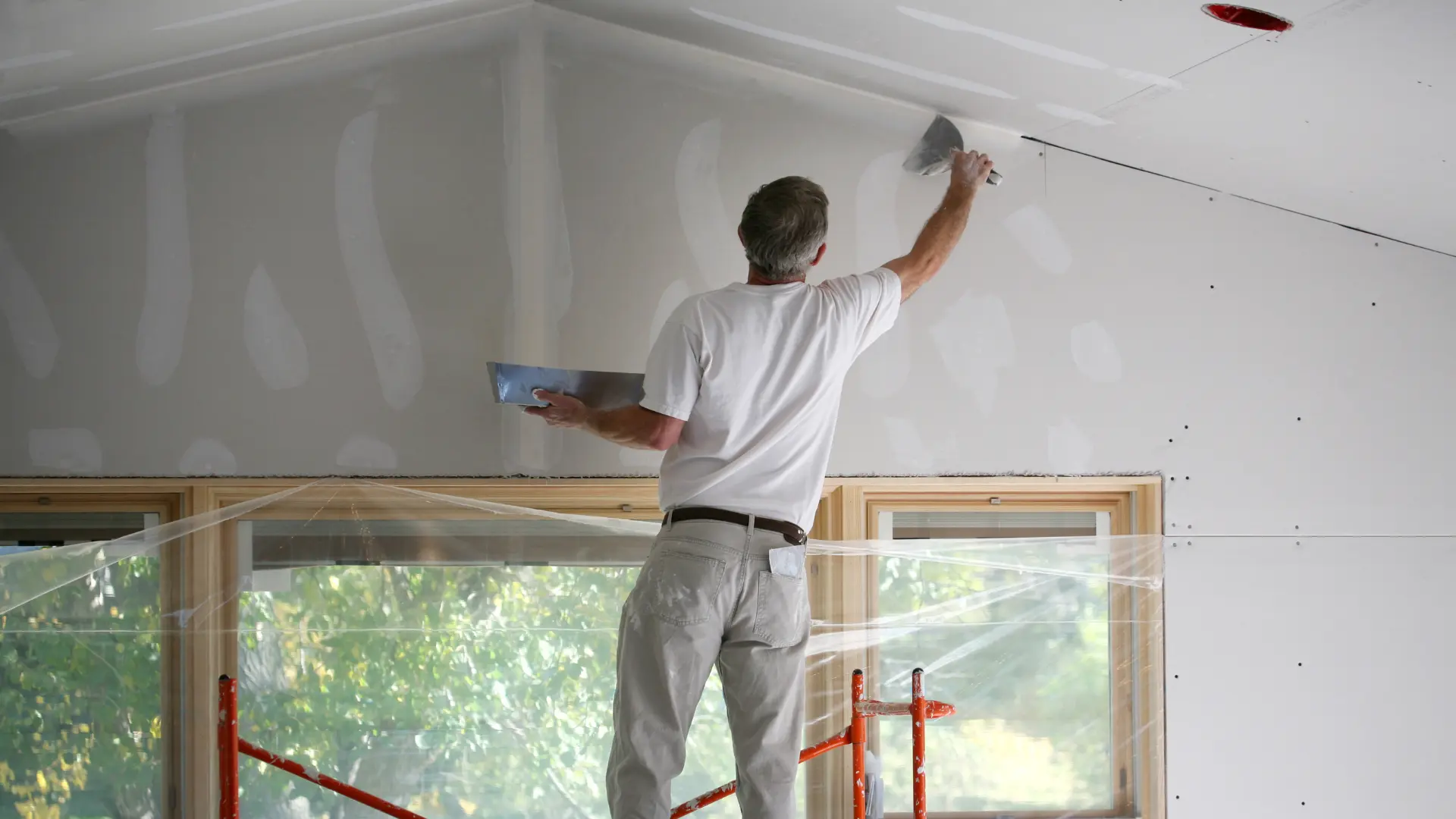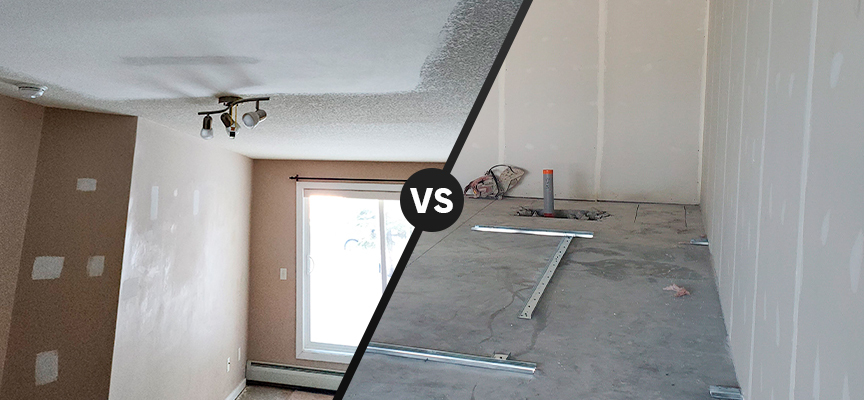Step-by-Step Approaches to Getting Flawless Drywall Repair Work and Installation
Attaining remarkable drywall repair and installation requires an organized strategy. It entails comprehending the different types of drywall and the devices required for the job. Appropriate location prep work is vital before starting any type of work. drywall contractor. Each step, from covering holes to setting up new sheets, needs interest to detail. The process does not end with setup; completing techniques are vital for a polished look. The next actions will guarantee a smooth result, yet just what do they entail?
Comprehending Drywall Types and Equipment Needed

The installment devices are similarly vital. An utility blade is essential for reducing drywall sheets, while a drywall saw can assist in making accurate cuts for fixtures or electrical outlets. T-squares ensure accurate measurements, and drywall screws or nails safeguard the panels to wall surface studs. Furthermore, a drywall lift can assist in the installation of large sheets, minimizing physical pressure. Knowledge with these tools and types significantly adds to the effectiveness and top quality of drywall projects.
Preparing the Area for Repair or Setup
Preparing the location for drywall fixing or setup is vital to ensure a effective and smooth process. Initially, the surrounding space ought to be removed of furnishings and other barriers to offer enough functioning space. This not only guarantees safety and security however additionally avoids damage to items. Next off, it is vital to cover the floor with ground cloth to capture any kind of debris or dust created during the work.
Additionally, the wall surfaces ought to be evaluated for any type of loose paint or wallpaper that may disrupt bond. Getting rid of these components creates a clean surface area for the brand-new drywall. Before start, it is advisable to switch off power to electric outlets or fixtures in the vicinity. Guaranteeing adequate lights in the work area will better enhance exposure and focus throughout the repair or installment process. drywall contractors. By diligently preparing the area, one prepares for an effective drywall project
Step-by-Step Refine for Patching Holes
:max_bytes(150000):strip_icc()/SPR-solutions-to-common-drywall-problems-p2-4120949-not-on-stud_53719-051c5226ba8f478086c3994975acf8c9.jpg)
Patching holes in drywall requires a systematic technique to ensure a smooth fixing. The very first action involves evaluating the dimension of the opening. For little openings, a patching substance may be sufficient, while larger holes require a patch. Next, the broken location should be cleaned and prepared by removing any kind of loosened debris.
For small holes, using spackling substance with a putty knife is suggested, smoothing it over the hole and feathering the edges. As soon as completely dry, sanding the location ensures a smooth surface. For bigger openings, a drywall spot must be reduced to size, positioned over the hole, and safeguarded with screws. After setting up the spot, the very same spackling procedure is repeated, complied with by sanding.
Finally, the patched location has to be keyed and repainted to match the surrounding wall surface. This meticulous process guarantees a professional look and prolongs the lifespan of the repair service.
Installing New Drywall Sheets: A Comprehensive Guide
Installing brand-new drywall sheets requires careful planning and execution to ensure a tough and visually attractive surface. First, the area has to be determined link properly to identify the number of sheets required. It is crucial to choose the right density, usually 1/2-inch for interior wall surfaces and 5/8-inch for ceilings or fire-rated applications.
Next off, the studs or structure must be evaluated for any abnormalities, making certain they are lined up and appropriately spaced. When positioning the drywall sheets, they must be placed flat to decrease joints and enhance structural stability. A drywall lift can be beneficial for overhead installments.
Securing the sheets with drywall screws at ideal periods makes specific a secure installment. It is essential to countersink the screws slightly below the surface area to get ready for the finishing procedure. Following these guidelines will lead to a strong foundation, prepared for the following actions in drywall completing.
Finishing Touches: Taping, Mudding, and Sanding Methods
When the drywall sheets are securely secured, the focus moves to the complements that will certainly supply a refined look. This process begins with taping, making use of either paper or fiberglass mesh tape to cover the joints in between sheets. The tape guarantees a smooth change, minimizing the danger of cracking. Following taping, mudding is important; a joint substance is applied over the tape to fill spaces and develop a seamless surface. Generally, several layers are required, each one feathery out better than the previous to reduce presence.
After adequate drying out time, fining sand is the last action in achieving a remarkable surface. A fine-grit sandpaper is used to smooth the dried out compound, ensuring there are no bumps or blemishes. Focus to information during this phase is considerable, as it substantially impacts the general appearance of the wall. Completion outcome should be an also, professional-looking surface area ready for visit site priming and paint.
Frequently Asked Questions
How Do I Pick the Right Drywall Density for My Project?
To choose the appropriate drywall density, take into consideration the task's objective, location, and structural demands. Criterion densities include 1/2-inch for general use have a peek at this site and 5/8-inch for fire-rated applications, ensuring sturdiness and conformity with building ordinance.

Can I Set Up Drywall Over Existing Drywall?
Yes, installing drywall over existing drywall is possible. It is crucial to assure the underlying surface is totally free and safe from damage. Appropriate attachment and consideration of thickness are vital for a successful installation.
What Are the most effective Practices for Drywall Disposal?
The very best techniques for drywall disposal include reusing when feasible, utilizing regional waste monitoring solutions, and adhering to guidelines for dangerous products if suitable. Drywall Repair Ogden UT. Correctly labeling and sealing waste warranties compliance and safety during disposal
How much time Should I Wait On Mud to Dry Before Fining sand?
Normally, one should wait 1 day for drywall mud to completely dry prior to fining sand. Drying out time can vary based on moisture and temperature, so examining for a company texture is suggested prior to continuing.
Are There Eco-Friendly Drywall Options Available?
Yes, environment-friendly drywall choices are offered. These alternatives commonly use recycled products, low-VOC adhesives, and sustainable production methods, lowering environmental influence while offering effective insulation and longevity for different building and restoration jobs.
An energy knife is crucial for reducing drywall sheets, while a drywall saw can aid in making exact cuts for electrical outlets or fixtures. Preparing the area for drywall fixing or installment is crucial to assure a smooth and reliable process. Covering holes in drywall calls for a systematic method to ensure a seamless fixing. Mounting brand-new drywall sheets needs cautious planning and execution to assure a tough and visually attractive surface. Yes, mounting drywall over existing drywall is possible.